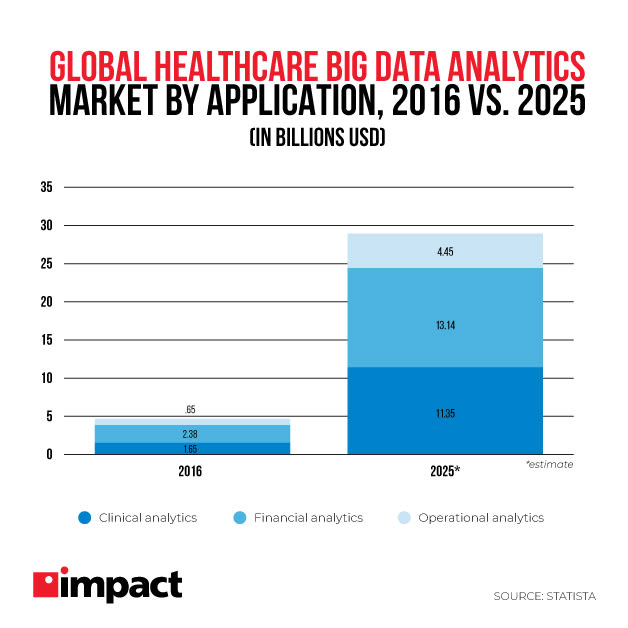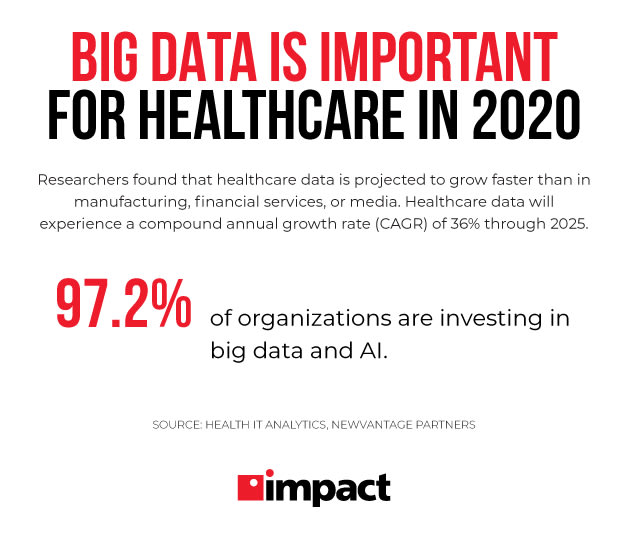What is Big Data in Healthcare?
Big data in healthcare is the huge amount of information gathered by collecting, storing, and analyzing data within the healthcare industry. Data helps providers understand patients better and give them more personalized care. Additionally, it improves the overall performance of their practice.
Big data is becoming more commonly used because modern medical practices now possess more information than they ever have before because digital programs, apps, and tools are more prevalent than ever, too.
Because of this and the huge amounts of data being collected, it’s not viable for humans to go through this information themselves. Instead, hospitals are using digital means to capture and assess data, then providing practitioners and other healthcare professionals with actionable and easy-to-understand reports to help them make the best decisions possible.
Want to make more use of your data? Download our eBook, Fast-Tracking Your Digital Transformation, to see how you can set your business up with the technology it needs to use big data to enhance decision making organization-wide.
Why is Big Data So Important Today?
When we say that practices have more data than ever before, we don’t just mean a little bit more. We mean an industry-changing amount more—in the last four years the amount of data held by healthcare providers has increased nine-fold.
Healthcare organizations have seen an explosive health data growth rate of 878% since 2016, according statistics compiled by Dell EMC.
While this figure may be a shock, it is in fact mostly in line with what has been occurring in virtually every industry over the last 10 years. Whether it’s manufacturing or retail, businesses in every industry are being affected by the massive growth in big data.
When you combine this with the relative cost-effectiveness and ease of implementation for systems that can make use of big data sets, then you have a business landscape that is being upended. And healthcare is no different, and its importance will grow, just as it has with other industries, as we go forward into the new decade.
How Are Healthcare Providers Using Big Data?
Helping Providers Improve Staff Management
Managing staff and shifts is absolutely crucial for providers. With costs rising, over-staffing can have significant effects on your bottom line.
At the same time, an understaffed provider won’t be looked at favorably by patients if their care is affected.
By establishing a system that can assess historical admission rates, big data sets can be automatically analyzed, allowing you to see when you’re busiest down to the minute.
Hospitals are already doing this—in one instance a provider used machine learning to trawl 10 years’ worth of admission data.
The analysis they received showed shift managers the predicted admission rates on any given day for the following two weeks, which they then used to more efficiently allocate shifts to staff.
Increase Patient Engagement with Data
Most of us are familiar with wearable devices, but the information they provide and their use in healthcare as a means for primary care physicians to assess their patients is another way providers are using big data.
There are wearable devices available to consumers for a vast array of uses. Here are a few examples:
- Fitness trackers: FitBits are probably the best-known example, equipped with sensors to help users track their physical activity and monitor their heart rate
- ECG devices: Help users monitor their heart rate, heart rate variability, respiratory rate, temperature, and activity
- Blood pressure monitors: Use oscillometric technology to measure blood pressure
What’s the significance of these?
They can report data directly to a patient profile, which your PCP has on record. If something is abnormal, like heart rate, temperature, or blood pressure, the doctor can be alerted and then can contact the patient and arrange a consultation. This is especially useful for older or at-risk patients.
Practitioners Can Use Data for Preventative Medicine
Big data relies on structured data in order to conduct automated crawls. Of course, the issue with this is that healthcare (like many industries), is inundated with unstructured data that makes it difficult for humans to make the most effective use of it. If someone dumps an Excel spreadsheet on your lap with thousands of rows of numbers and statistics, there’s no way you’d be able to make sense of it. The data is there, but you need help to define what it means to you and pick out the insights that you can use.
80% of medical data remains unstructured and untapped after it is created (e.g., text, image, signal, etc.). This type of data is too hard to handle for most hospital information system, it tends to be ignored, unsaved, or abandoned.
And this is why providers are turning to machine learning. It can go through your data and produce actionable insights for physicians to use. What this means is that unused data is now available and can be used to identify medical conditions that weren’t apparent before.
Use of Structured Data Reduces Errors
One of the biggest benefits of data analytics implementation is the reduction in human error wherever possible.
Many administrative tasks that are vital to the running of a healthcare provider, such as documentation for bills, records, and statements, are susceptible to human error.
Most healthcare organizations use human review to manually classify and extract data from Medicaid documentation, such as hospital bills, tax forms and bank statements. This is a costly and time-consuming process, with error rates for data entry as high as 4%. That comes out to 400 errors per 10,000 data points, a significant number that could jeopardize care.
It’s no secret that healthcare organizations want to remove even the smallest possibility of errors; in fact, 91% of executives rank reducing medical errors as a high or very-high priority compared to other clinical initiatives at their health system.
Providers are increasingly turning to digitization solutions to help alleviate this, using document capture processes that read forms and other data mediums, automatically entering the information into your database rather than having a human manually process it.
AI and machine learning are helping these document processes by removing the human element and implementing digital document extraction that is more accurate. Machine learning improves with every capture, as it learns how to deal with validating data by drawing from an ever-extensive pool of previous captures.
Obstacles to Using Big Data in Healthcare
While there’s no doubt that big data in healthcare is becoming a must-have, there are also obstacles to its implementation.
While investment in big data from providers has seen huge increases over the last few years, the use of data as a whole is lagging behind other industries. Before it becomes truly mainstream, a number of concerns must be addressed.
One of the biggest concerns about the use of big data in healthcare is patient security. Regulations such as HIPAA must be abided by health organizations, but they are largely left to their own devices to figure out what policies they put in place to protect their patient’s data.
In addition, utilizing big data can be a daunting task. It requires personnel who are experts in data science, IT, or statistics. Additionally, practices need a communication policy that ensures that requested queries and reports from data administrators are up to the standard necessary for physicians.
Main Benefits of Big Data in Healthcare
As mentioned above, utilizing big data in the healthcare industry can bring big benefits.
- Improving Patient Care: The main benefit of big data in healthcare is how much it improves the overall patient experience. From proactive care to real-time health, the data tracked through big data helps make quicker and more accurate diagnoses.
- Reduces Costs: The technology used in big data reduces the costs associated with healthcare. It works by digitizing records and improving proactive care, lowering overall costs. More accurately tracked data also improves hospital care, shortening the time patients spend in facilities.
- Improves Reporting and Decision Making: More data means a greater ability to use data in decision-making. This means major decisions on health and business can be made using accurate, relevant information.
- Connects Patients With Providers: The connectivity presented by big data lead to a better connection between patients and healthcare providers. Reporting from connected health devices also makes it easier to see when something is wrong through real-time alerts.
The Outlook for Big Data in Healthcare
While there are obstacles to the use of big data in healthcare, using it is helping organizations in several ways. First, financially, in administration, and for the provision of healthcare services, most importantly.
As the industry progresses, big data continues to be adopted by providers as they leverage its benefits.
For organizations that are unsure of how they can utilize big data, it’s OK to start small. Try it first with systems for administrative office purposes before implementing advanced measures.
Nonetheless, we can expect widespread adoption of analytics and automation in the healthcare industry by as early as the mid-2020s. Providers should strongly consider adopting big data technologies as soon as possible to keep up.
Key Takeaways
- The amount of big data present in healthcare organizations is vast and increasing, but many providers do not utilize it.
- The uses and benefits of big data analytics are growing every year.
- There are still hurdles for providers to overcome, particularly with regard to data security and compliance.
- Big data utilization will increase over time as the healthcare and financial benefits become more apparent and cost-effective to implement.
To make the most of your data, you need the technology and tools in place to organize, structure, and store data, along with building usable reports with it. Accomplishing this involves transforming the way your business works with data. See how you can fast-track that digital transformation by downloading our eBook, Fast-Tracking Your Digital Transformation.


